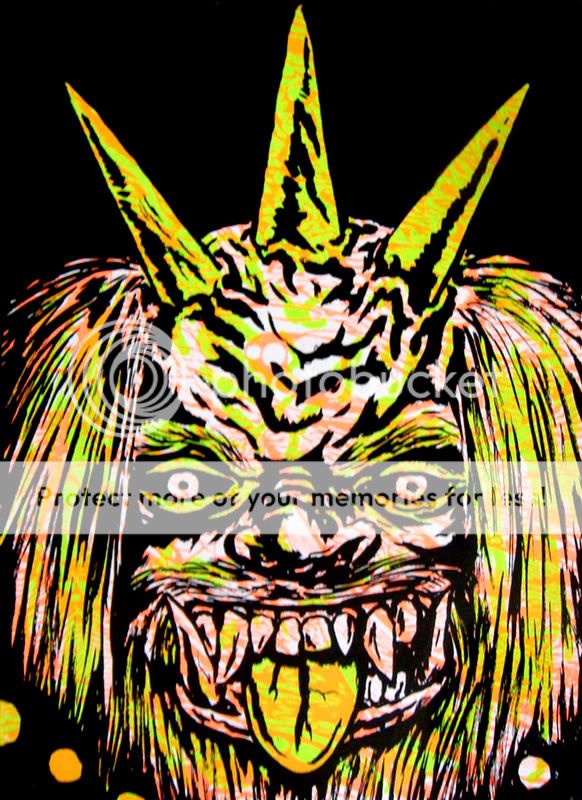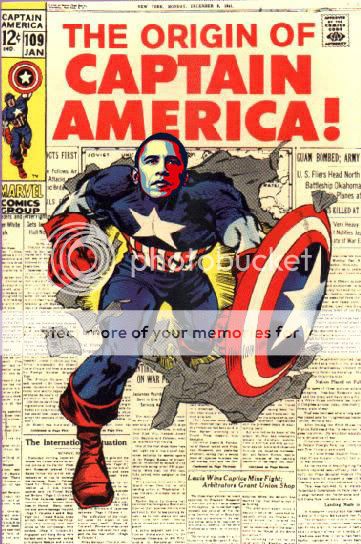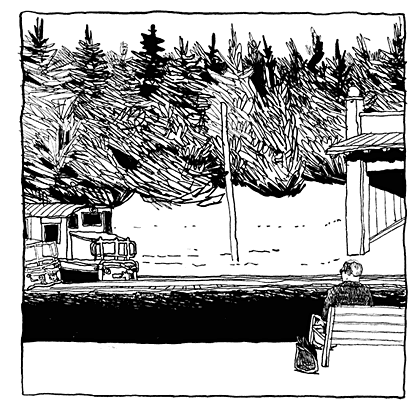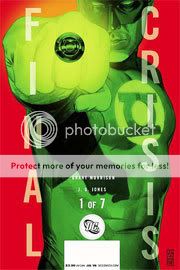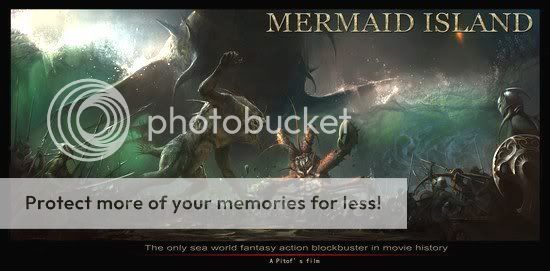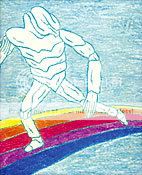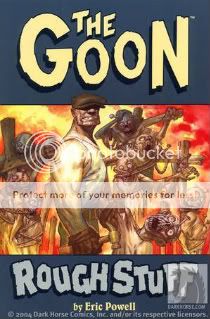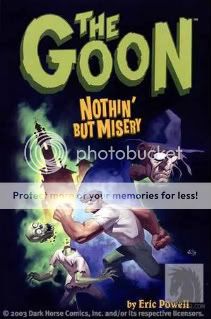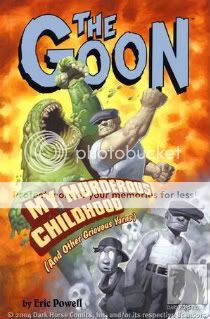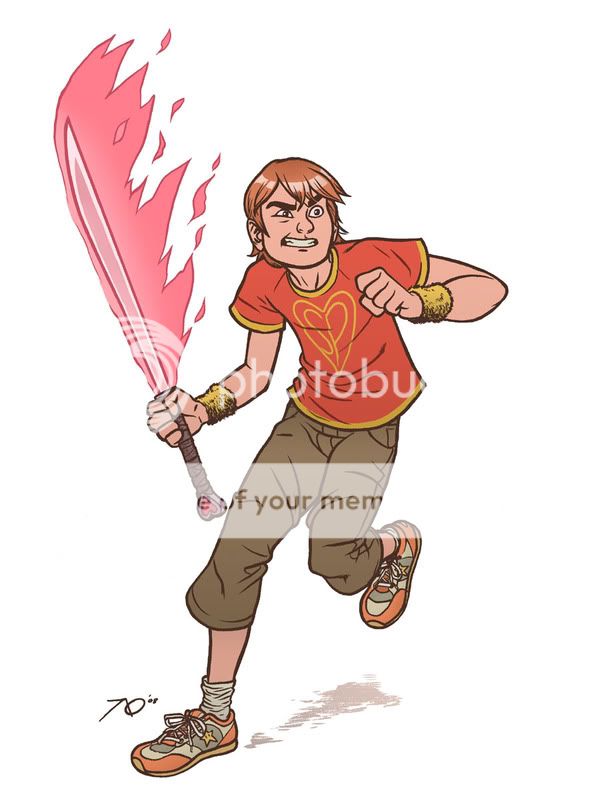Author Archive
Comics Time: Aqua Leung Vol. 1
June 9, 2008Aqua Leung Vol. 1
Mark Smith, writer
Paul Maybury, artist
Image, April 2008
208 pages
$17.99
Here’s a book you can’t help but compare to other, similar projects that are mining this same vein of ad-hoc epic and homegrown myth(os)-making. Consider it the “A Star Wars of One’s Own” school. (I’ve dabbled in it myself.) The book I kept thinking of when reading it is Mouse Guard. This one comes out on top in virtually every way.
First of all it’s the rare independent comic that comes equipped with not one but two editors, including one seemingly solely dedicated to copyediting. And man, does it help! The story is a coming-of-age hero quest that frequently indulges in knowingly arcane dialogue, and it’s really easy to aim for “fancy” and end up hitting “gibberish.” This doesn’t happen here, which is a blessing right there.
Second, there’s Paul Maybury’s art. Don’t get me wrong, I think Mouse Guard‘s Mark Peterson is obviously a gifted illustrator, and also a better sequential artist than he perhaps might get credit for. But Maybury is something of a revelation here, his thick brush line (apparently this is his first-ever brush art!) at different times approximating the Paul Pope-Becky Cloonan art-blob vibe, the more manga-inflected Vasilis Lolos punk-action thing, some Bryan Lee O’Malley-isms in the character designs, and–out of left field–almost Fort Thunder-ish use of images-as-texture (a wall of “STOMP” sound effects, a two-page spread of arrows, a splash page consisting solely of clashing colors, and an opening map that looks like Ron Rege drew it), occasionally peeling back to an effectively crude, almost childlike minimalism. Colorist Russ Lowery is a break-out star here too, combining Lolos’s candy-coated palette with Dave Stewart’s subtlety and lushness. Smith’s script gives the pair plenty of room to play, with almost abstract combat scenes and bravura sequences like the Spaceball One-sized sea-monster whose jaws take fully four pages to traverse our viewpoint.
Speaking of Smith, he brings a most welcome sense of humor about the grandiose nature of this project to the table, something Mouse Guard lacks entirely. Will you wish he hadn’t kept The Hero with a Thousand Faces next to his laptop as he wrote this story? Sometimes, yeah. (Enough with the fucking absent father figures already, genre writers of America!) At first the epic saga-osity of the material gets the better of him–he burdens the story with something like four introductory sequences, and lets an omniscient narrator tell things that should be shown early on. But the structure smoothes out as the book goes on. Meanwhile he frequently undercuts any portentousness with a wink and a nod to his diverse sources, from the inclusion of a little octopus sidekick that feels like something out of a Japan-only video game to shots of the titular young hero peeking up girls’ skirts, flashback-sequence from Splash-style. And the approach to the violence is more Indiana Jones than Star Wars, if that makes sense–while it does move the plot and is supposed to inspire the awe of any good action sequence, it also unfolds like a choreographed routine and draws attention to that fact. What’s more, he sticks the landing with a climactic battle that feels climactic yet also naturally subservient to whatever will happen in the subsequent volumes.
Overall there’s really nothing here that leaves you feeling like everyone involve needs to get out of their parents’ basement in some fundamental way–it feels like grown-ups knowingly playing with their old action figures more than grown-ups trying to pretend that those action figures are for grown-ups. Nor does it mistake the modest aim of telling the story of its creators dreams for the delusional grandeur of Telling The Story Of Our Collective Unconscious. And oh yeah, the lettering and logo by Fonografiks is really kinda perfectly METAL. I even like the paper and cover stock. It’s a good time.
Carnival of souls
June 8, 2008* Not everyone who gets stranded on a deserted island winds up on one with Elizabeth Mitchell on it. No, some folks–like five divers who got swept 20 miles away from their boat by the current and had to seek shelter on the Indonesian isle of Rinca–wash up on a beach where they get attacked by a Komodo dragon. Try to imagine spending hours adrift at sea, desperately swimming to the first land you can find, then looking up and finding a dinosaur is chasing you. (Via Tim F.)
* A new batch reminds me that stills from Midnight Meat Train are always pretty. I’ve got high hopes for this film and it’ll be a shame if the release is uber-limited or otherwise botched.
* Go, look: Mat Brinkman in the studio! (Via Monster Brains.) At MoCCA this weekend my table was directly across from PictureBox, and they had these killer Mat Brinkman pieces that stared me in the face all weekend long, silently tempting me to buy them despite how they’d probably go over when presented to the relevant persons as decorations for my new house.
* Finally, does anyone have a problem viewing this blog in terms of the body column being too wide so you have to scroll right to read each sentence, in Explorer or any other browser? Please email me if so.
Carnival of souls
June 7, 2008* The creators of The Wire have apparently decided to make a show that’s even easier for the writers of sociocultural thinkpieces to wax enthusiastic about and are adapting the nonfiction Iraq War book Generation Kill as an HBO miniseries. AICN’s review sums up the team’s, uh, appeal:
As you know, Ed Burns and David Simon were the writers/creators/producers of HBO’s “The Wire.” In my opinion, “The Wire” is hands-down the best show ever made. Period. End of discussion. Sure, I love “The Sopranos,” “Lost,” the Whedonverse, and several other TV staples, but what makes “The Wire” excel above all the rest, is its journalistic approach to filmmaking. Simon and Burns use TV, as a writer uses a notepad. No flash or bombast. No overreaching character arcs designed to bludgeon you to death with their profundity. They’re intent is not to entertain, but to inform.
Swell.
* Kristin Thompson will be attending San Diego Comic Con. To participate in a Hobbit movie panel. The Film Studies 101 student in me just can not get over this.
* CRwM gives the business to mainstream critics who feel it’s their solemn duty to Speak Truth to Genre.
* Finally, I just want everyone looking to keep cool tomorrow from 11am to 6pm to know that my table at MoCCA, in same corner as PictureBox and Pantheon, is perhaps the most air-conditioned place in the New York metro area. Just sayin’.
Comics Time: The Aviary
June 6, 2008The Aviary
Jamie Tanner, writer/artist
AdHouse, June 2007
312 pages
$12.95
I was challenged and intrigued by the idea of, and the ideas in, this debut graphic novel, comprising various interlocking minicomic and anthology strips. “The Aviary,” as we slowly come to realize, is a term for a strange, insular city peopled by various subconsciously resonant weirdos: an art-porn impresario who is also an anthropomorphized monkey, a sexy but viciously nasty receptionist, a limbless stand-up comedian, and so on. Popping up throughout is a blinking bird-headed doll/automaton called the Silent Bird-Man, alternately a symbol of reproachful authority and libidinous secrecy. Some clever shifts in the temporal order of the events being presented lead to a mobius-strip vibe reminiscent of one of David Lynch’s psychogenic fugue films; yes, it’s a shorthand way to connote depth and weirdness, but it’s an effective shorthand way to do that. On a script and story level, the project falls somewhere between Ed the Happy Clown and Asthma, not nearly as assured as either (easy anachronism is a sure-fire way to lose me, comics writers of America), but promising for how it plays with those tools.
The problem is the visuals. Tanner’s pen-and-ink line is reminiscent in some ways of Rick Geary’s–not least because of its old-timey affectations–but his overall sense of page design and panel framing lacks Geary’s inventiveness and storytelling brio. I think literally every single shot of every single character in the book is either head-on or in three-quarter profile, like they’re spending the whole book cheating to the audience. And they’re almost always shown in close-up or medium-shot–seriously, you’re as likely to see feet here as you are in a Michael Turner comic. The combined effect simultaneously makes the comic feel artificial and saps it of its energy. This is all compounded by an overuse of word balloons and figures that break the panel walls for no discernible reason, again making the images feel stagey. Meanwhile, the character designs blended together for me, making the already byzantine plot even more difficult to follow.
Overall, this is what you’d call a promising debut, but not in the blandly complimentary way that’s usually said–I really mean it’s noteworthy for the promise it demonstrates with regard to potential future works. What I’d like to see is Tanner throw this against the wall hard, to see what sticks, to see what’s broken, and to see how he can put something new, different, and better together with the pieces.
Carnival of souls
June 5, 2008* Now here’s a great one, horror fans: Film blogger Girish Shambu initiates a discussion of horror movies, specifically whether there are films or filmmakers whose work is so revolting or frightening you can’t bring yourself to (re-)watch them. The post and the extremely rewarding comment thread address horror from the perspective of bona fide cineastes whose primary interests in film lie elsewhere–a really fascinating viewpoint for those of us immersed in the genre on a daily basis. Curt, CRwM, B-Sol, Bruce, Ken, Jon, Steven, Jason, I hope you’re reading…
* Lionsgate has changed the release date for The Midnight Meat Train again. Now it’s not coming out till August 1st. For those keeping track at home, it’s gone from May to August to July back to August again. Either they saw how The Strangers did and want to give it a little more breathing room instead of putting it up against Hellboy II, or they really just don’t give a crap.
* Dawn of the Dead/300/Watchmen director Zack Snyder will not be directing his long-discussed epic zombie movie Army of the Dead–that honor falls to “commercial director and visual artist” Matthijs van Heijningen. So, that’s what that is.
* Bruce Baugh reviews Dan Simmons’s historical horror novel The Terror, focusing on the disconnect between the first three-quarters of the book and its denouement. I personally liked the shift, yet I was still left feeling, as Bruce does, that I’d sort of wasted my time in getting there.
* Curt Purcell returns to CRwM’s torture-porn post series, this time singling out the aspects he found really successful.
* Call me crazy, but $115 for every single tie-in issue of the DC summer event Final Crisis seems not unreasonable to me. That’s going to be six or seven different trade-paperback collections when all is said and done, right? If you’re really into DC, it’s sort of like buying two or three complete-season HBO on DVD box sets. The other thing to think about with these sorts of cost-analyses for sprawling multi-title crossovers is that the kinds of people who are crazy enough to buy every single issue for completism’s sake–the people who plunk down money for Countdown: Arena or the World War Hulk issues of Heroes for Hire–have long ago made the bargain with themselves that this is how they will spend their disposable income. You might as well bemoan the cost of limited-edition Nikes to a sneaker collector who’s got a closet full of them. (Via Topless Robot.)
* Speaking of Final Crisis, here’s Tom Spurgeon’s review of the first issue. I admit that my own was largely constructed as a counterpoint to Tom’s.
* Go, look: Matt Furie art! (Via Monster Brians.)
* My friend David Paggi interviews Jason, arguably the most underappreciated cartoonist going right now.
* Jog reviews Richard Corben’s House of Horror: Lovecraft #1.
* The Onion A.V. Club interviews Joel McHale, the host of The Soup. One thing both the interview and the comment thread get at is that part of the reason the show is so funny is because Joel’s contempt for the stupid shit he’s making fun of is clearly genuine. (Via Jim Treacher.)
* For some reason my RSS reader coughed up a bunch of random, old posts from Reverse Shot today, and among them was a post by CNW on the opening arc of The Sopranos Season Six, Part One that I really enjoyed.
* Hooray for nostalgia! My pal Jesse Thompson runs down the 10 Greatest Girls Toys Secretly Coveted by Boys for Topless Robot. I’m right there with him on She-Ra. It’s like a He-Man expansion pack!
* Your quote of the day comes from The Mystery of the Haunted Vampire’s Carnacki:
…why do I blog? For the same reason I grow sunflowers. I like it and if other people see it and like it, that’s great. It’s as simple as that.
* And your image of the day comes from Eric Reynolds:
Top Shelf Brings You Some Peace of Mind
June 5, 2008For today’s daily webcomic on Top Shelf 2.0, editor Leigh Walton has been kind enough to repost my and Matt Rota‘s It Brought Me Some Peace of Mind. It’s the story of a man named Andrei Chikatilo and his enthusiastic, if idiosyncratic, patronage of the Ukrainian mass transit system. I hope you enjoy it.
This is as good a time as any to remind you to be on the lookout for my 44-page comics anthology Murder, designed by Matt Wiegle, at the Partyka table at MoCCA. I hope you enjoy that too!

Comics time: Final Crisis #1
June 4, 2008Final Crisis #1
Grant Morrison, writer
J.G. Jones, artist
DC, May 2008
40 pages
$3.99
I first read this while standing in Jim Hanley’s Universe during my lunchbreak the day it came out. My first impression was basically flat. Brief, largely undramatic scene after brief, largely undramatic scene featuring a myriad of unconnected characters from across the sprawling DC Universe–a product of hundreds or thousands of writers and artists over going on eight decades, cobbled together by corporate fiat…there was certainly a lot going on. It’s got to be the most continuity-heavy Major Event launch…well, ever. Or at least since Crisis on Infinite Earths #1.
That said, I don’t really care about whether it fails as a launchpad, jumping-on point, blockbuster, next chapter in the DCU, whatever. I just wonder if it succeeds as a Grant Morrison comic, because I don’t care about “The DCU” in the slightest, but I do care about the writing of Grant Morrison. And after that first read, I felt that I really didn’t have enough to go on. I did enjoy seeing Martian Manhunter get punked out, though. As I always say, kill ’em all. I also thought it was hilarious that Morrison was writing this mega-massive-major tentpole summer blockbuster comic the same way he wrote his weird opus Seven Soldiers–super-dense, chock full of elided dialogue and action, and necessitating multiple reads to make heads or tails of it.
Then I got a copy of it in the mail from DC, so I was actually able to sit down with it, re-read the whole thing, and flip around and re-read certain parts. And you know what? Now I kind of love this comic. It’s creepy, weird, totally jam-packed with ideas, paced in a very daring way for what’s supposed to be a popcorn comic (no big reveals, no shocking moments, no wish-fulfillment–compare it to the entertaining but comparatively straightforward “shocking season premiere” feel of Secret Invasion), it has a kind of nauseatingly blasé death for one of the DCU’s oldest mainstays, I love the Dark Side idea (Jack Kirby’s evil demigods falling to earth and taking human form), major plot points are conveyed simply through panel transitions and body language…I keep coming back to the Martian Manhunter’s death, which has more impact precisely BECAUSE it’s neither a big hero moment or a failed attempt at a big hero moment (“Not like this! NOT LIKE THIS!”). The pacing of it conveys the lack of regard for human life that these douchebag villains have. And certainly the shittiness of evil, as opposed to its grandiose awesomeness, has been a running theme of Morrison’s superhero work for a long time now.
Sometimes the art is rushed-looking–Superman looks like he’s stupid, and the table at which the Secret Society of Super-Villains parlay with mysterious asshole villain Libra changes sizes from panel to panel. But there’s a lot of great facial-expression stuff in there too, as in the Anthro vs. Vandal Savage fight, the confrontation between Boss Dark Side and Terrible Turpin, the Anti-Life kids…
Even the deadweight Monitors from Countdown seem like they have a weird society instead of just running around proclaiming shit like they used to. And who cares whether it ignores what happened to the New Gods in previous would-be event miniseries over the past year? Ignoring stuff you don’t care about is done every time a superhero writer working on a decades-old character hits a key on his laptop–so what if the thing he’s ignoring happened three months ago instead of in 1957? It’s a very good comic for me.
Murder, he wrote
June 3, 2008If you are attending MoCCA this weekend, won’t you please consider buying Murder? It’s a 44-page anthology of comics (some never before seen by anyone anywhere) written by me and drawn by Matt Wiegle, Matt Rota, and Josiah Leighton. Matt Wiegle designed it and put it together, so you know it’s nice-lookin’. It (and I) will be available, along perhaps with another interesting item or two of mine, at the Partyka table. The cover looks like this:
Carnival of souls
June 3, 2008* I’ve frequently talked about how much I loved, and love, He-Man and the Masters of the Universe–the prototype for the genre-mashup “art of enthusiasm” I enjoy so much today. El Mayimbe at Latino Review has a lengthy synopsis of a draft screenplay for a new film adaptation of the franchise by Justin “The New David Goyer” Marks. On the one hand, Mayimbe says:
It’s a hard and edgy PG-13 tinkering on [sic] a [sic] R. The script has ZERO CAMP or CHEESINESS. NO FUCKING ORKO EITHER! The writer takes the MOTU mythology very seriously. Whatever made the cartoon corny is not in here at all. In fact, there is not a single beat of comedic relief [sic] in the script.
Which, you know, barf. God forbid we don’t take a franchise that featured a half-skunk half-man named Stinkor seriously!^ However, it’s possible that to translate the awesome-(in the awe-provoking sense)-to-a-five-year-old quality of the original toys and cartoons to a modern blockbuster audience, you have to jump into the madness of it all with both feet; winks and nods toward admitting the original was goofy may just lead to a a watered-down G.I. Joe-style attempt to flatten the weirdness into a conventional action-flick mold. The screenplay sounds fun enough, ripping off Peter Jackson’s Lord of the Rings films (right down to an “in ancient times” prologue nominated by a powerful woman from the film’s present) and the superhero-in-training movies of today just as unabashedly as the old He-Man stuff ripped off Heavy Metal and D&D, which is probably as it should be. And the He-Man world’s po-faced mixture of fantasy and science-fiction is apparently a very big deal to Marks. So we’ll see. (Via AICN.)
* A good day for rants, part one: Ken Lowery bemoans Hollywood’s perennial failure to follow up for-women smashes like Sex and the City with more movies for women. Romantic comedies–which my mother calls “sappy crappies”–don’t count.
* Curt Purcell responds to CRwM’s epic series on torture porn, defending the “High Horrorism” of supernatural horror and arguing that fusty Victorian/Edwardian notions of dread actually date back to prehistoric, even primordial times. It’s a great post, though I want to add two things: 1) I don’t think CRwM went nearly as far in the “supernatural horror sucks because it’s too unrealistic” direction as Aaron Weisbrod’s old Dark But Shining essay on that notion, and good on CRwM for that; 2) the comment thread at Curt’s post is the usual roundelay of pro forma, largely baseless responses to the torture porn issue (they suck; they’re just slasher movies but not as cool; the term “torture porn” is insulting to the horror genre) that Curt and CRwM’s posts on the topic have commendably avoided.
* A good day for rants, part two: Look, I’ve got a lot of problems with the superhero movie wave of the past few years, including (heck, especially!) the supposedly good flicks, let alone the real dreck. Even so, I found Chris Nashawaty’s anti-superhero-movie piece at EW to be perhaps the most sloppily researched and argued genre-entertainment thinkpiece it’s been my misfortune to come across in literally years. You truly have to read it to believe it–it’s so bad I don’t even know where to begin.^^ Fortunately I don’t have to: My pal Zach Oat at Movies Without Pity takes a chainsaw to Nashawatay’s strawman arguments, factual distortions, generally abysmal critical judgment, and sucker-punching of Stan Lee. (The Man is a complicated figure in comics history who has a lot of things to answer for; churning out drab, cookie-cutter ideas during his ’60s-era heyday is most certainly not one of them.)
^ Do no fanboys realize that hating Orko, Snarf, the Ewoks, et cetera because they make fucking He-Man, Thundercats, Star Wars, et cetera too silly is ridiculous beyond comprehension? Have they never watched the rest of He-Man, the Thundercats, Star Wars, et cetera?
^^ Okay, that’s not quite true: Anyone who apparently loves Independence Day forfeits their right to complain about X-Men: The Last Stand. Or, really, anything else.
Carnival of souls
June 2, 2008* Horror triumphalism alert! You’ve got to get a kick out of Bloody Digusting’s take on The Strangers‘ $20 million box office success this past weekend:
Un-freakin-believable! This weekend horror took a huge step forward by taking on not only INDIANA JONES IV, but the highly anticipated SEX AND THE CITY in a three way box office battle. Obviously Rogue Pictures’ The Strangers (review) took the number three slot, but to pull in $20 million opening weekend against two giant blockbusters in the middle of summer is such a wonderful sign. Hopefully this will light a fire under Rogue’s ass to greenlight Hack/Slash, which is now near the top of my list as most anticipated horror films in the works. Hurray for horror!
It’s probably churlish to unpack this point by point, but: a) one horror movie doing very well does not mean “horror took a huge step forward”; b) one stylish, upscale-marketed horror film does not make an adaptation of a splatstick comic book whose heroine has posed for Suicide Girls any more likely; c) hooray for horror indeed. At least B-Sol at the Vault of Horror frames the reason to be excited for The Strangers‘ haul purely in box-office terms, citing it alongside Prom Night and presumably The Happening (though oddly omitting Cloverfield or the holiday-season smash I Am Legend) as signs of a strong financial year for the genre. As always I caution against touting the success of films of various origin, style, tone, content, and intent as some sort of victory for Our Beloved Genre.
* LOST SPOILER WARNING: I sadly forgot to link to this last week, but man oh man, is Lost‘s Harold Perrineau angry about how things went down for him on the show. Maybe slightly less so now, but hoo doggy. For what it’s worth, if I were him I’d be angry too; it’s easy to see how Michael could have become a main focal point of the show upon his return, and that not happening would be disappointing for any actor. However, given the horrendous paternal history of virtually every character on the show, his argument that the severing of Michael from Walt reinforces stereotypes about irresponsible black fathers really doesn’t hold any water. I mean, it’s not like Locke, Ben, Jack, Claire, Aaron, Kate, Sawyer, Sun, Alex, Hurley, and Penelope have great male role models either! (Via The Tail Section.)
* Jog reviews Gilbert Hernandez’s Speak of the Devil, a book I haven’t read. I bet it’s good.
* Finally, the guy who directed Catwoman is helming some sort of undersea fantasy epic called Mermaid Island, and its promo art looks like this.
Any chance the film will be half as crazy and awesome? Yeah, I doubt it too.
Comics Time: Kramers Ergot 4
June 2, 2008Kramers Ergot 4
Anders Nilsen, David Lasky & Frank M. Young, Renee French, Lauren Weinstein, Marc Bell, John Hankiewicz, Mat Brinkman, Ron Rege Jr, Sammy Harkham, Jim Drain, Ben Jones, Dave Kiersh, C.F., Stepan Gruber, Joe Grillo, Josh Simmons, David Heatley, Souther Salazar, Genevieve Castree, Allison Cole, Leif Goldberg, Tobias Schalken, Jeffrey Brown, Billy & Laura Grant, Jason T. Miles, Kenny, Andrew Brandou, writers/artists
Sammy Harkham, editor
Avodah Books, June 2003
Pre-order a fancy-sounding hardcover re-release from Amazon.com
For me at least it’s difficult to separate Kramers Ergot 4 from how it came into my life. The book made its debut at the first MoCCA festival, joining Craig Thompson’s Blankets in the “big giant powder-blue books that knocked everyone out” sweepstakes; all three events–Kramers, Blankets, and MoCCA itself–turned out to be milestones in my comics-reading life. In terms of Kramers, even for someone weaned on Highwater and NON such as myself, this was heady stuff. I seem to remember there being passionate, even angry debates on my then-stomping grounds of the Comics Journal message board over whether it should have “wasted” pages on non-comics content like collages, and then other debates about whether those non-comics pages are, in fact, comics. It all seems pretty meaningless now–I don’t even remember what side(s) I was on–but I suppose the point is that the book really introduced me to completely non-narrative comics, a strategy I don’t think I’d given much thought to until then. I feel as though in a very real way it introduced comics to non-narrative comics, at least by virtue of becoming the most high-profile and influential release of that nature to date in the then-young decade. If you look at that contributor list and compare it to people’s 2007 Best Of lists, you can probably see the power it had.
In my defense, it is a powerful book. I would say it is in fact a book designed to overwhelm, from the sheer size of the thing to its small-army contributor list to the “yes, but is it art?” nature of so many of its contents. I mean, the textless Mat Brinkman “monsters clash on the Rainbow Bridge” cover is a statement practically begs comparison to the great Hypgnosis album covers for Led Zeppelin and Pink Floyd, even sharing a rainbow with The Dark Side of the Moon. Now that I think of it–and I promise I hadn’t, not even before my initial pass at this review–Dark Side is a great point of comparison in terms of how KE4 functions as a unit rather than as a collection of individual pieces. (There was little question in my mind as to whether I could approach talking about this anthology the same way I’ve done with MOME.)
See, one thing that struck me in giving the book a cover-to-cover read-through (the first time I’d ever done so) is that there are a surprising number of straightforward narrative strips given the book’s outré reputation. There are humor strips (Cole and Jones), autobio/slice of life (Brown), biography (Lasky & Young), underground-type sex’n’violence (Simmons), ruminative mythology-based storytelling of the kind that’s proven so popular (Nilsen), and just plain storytellin’ (Harkham). Even John Hankiewicz’s contribution has a discernible plot. Sure, they’re sprinkled throughout multimedia collages and Fort Thunder joy-of-markmaking exercises and multiple title pages and so on, but they’re there–sort of like how between the cut-up studio banter and looped analog samples and proto-ambient keyboards and psychedelic freak-outs, you can find unindictable masterpieces of rock-single construction like “Time,” “Money,” and “Us and Them” on Dark Side. Similarly, even these more easily graspable bits are, for the most part, pretty challenging in tone and content. Simmons’ contribution had me ready to put the goddamn book away the second he had a character take scissors to a puppy’s eye, Brown’s series of vignettes about dealing with the homeless, dangerous, or mentally ill is the most socially- and self-critical strip he’s ever done all at once, and Harkham and Nilsen’s contributions, “Poor Sailor” and a pair of Sisyphus strips, will no doubt make their creators’ all-time highlight reel. It’s kind of like creating a pop concept album about the pressures of late 20th-century capitalist society driving you insane until you die.
I’m not making this comparison because it’s cute. (I’m certainly not arguing that they sync up together, Wizard of Oz style.) I’m saying that Kramers Ergot 4 is put together the way it is on purpose, for the disorienting, overwhelming effect it has on the reader, how the narrative work lowers your guard for the nonnarrative, how the nonnarrative gooses your synapses and prepares you to focus on things you’re unaccustomed to focusing on in the narrative–how marks are arranged on the page, figures as symbols rather than as characters, design, the emotional impact of the strips rather than the plot-intellectual one. Instead of being a concept album, it’s a concept anthology. Hence the Dark Side comparison: In both cases there’s a sense of sprawl, of a thing you can’t possibly take in on the first pass and must return to and grab bits of meaning here and there, discovering new things each time. In both cases the material rewards repeat visits (I’m not sure I ever even read the Simmons strip before / I only figured out that the guy was saying “I certainly was in the right” a couple months ago). In both cases, as I’ve gotten older, I’ve grown to appreciate them more.
Battlestarcrossed
June 1, 2008So, Battlestar Galactica. As I’ve mentioned before in passing, this season’s emphasis on the show’s increasingly baroque mythology–both in the literal, religious sense and in the X-Files metaplot sense–has turned me off a bit, in no small part because it’s attracting the same kind of crazed devotion that Lost does from the some of the same Lost fans of my acquaintance who are also driving with that show too. To me the biggest symbol of this is the new opening sequence, which has shifted from laying out the need-to-know details about the Cylon threat to the equivalent of Lost having a thing at the beginning of every Season Four episode asking “Who’s in the coffin?” And duh, I’m obviously not the only person to connect the Final Five with the Oceanic Six.
That being said, I still find it engrossing, suspenseful, and completely unpredictable. And while the overemphasis on the mysticism, mythology, and Starbuck (Vision-Quest Variant) has obscured this somewhat, it’s still frequently moving and profound. There was a time recently when I was very, very down, and suddenly the sinister appeal of Gaius Baltar’s “God loves you because you are perfect” gospel of absolution from personal responsibility became frighteningly clear. Laura Roslin’s terminal illness storyline is as grueling as such storylines get (favorably reminiscent of similar plotlines from The Sopranos and Deadwood). The Final Four Outta Five are fascinating to watch in action. The Cally episode was heartbreaking. And so on and so on.
Which brings us to this past week’s episode, “Sine Qua Non.” I was thrilled to see Apollo and Tom Zarek back in action–the former has obviously been criminally underused this season, particularly considering how his blockbuster conduct at the Baltar trial set him up to become a strange and powerful new moral center for the show. I was thrilled to see a return to the political machinations, the struggle for a traumatized society to overcome turmoil, that had driven the show through its first three seasons. I liked seeing Romo Lampkin, that weird Shakespearean fool of a character, come back. I liked the kitty-cat. I liked the fistfight between Bill Adama and Sol Tigh. (Of course, I like everything about Sol Tigh.) I liked the clue that Sol’s impregnation of the captive Six afforded us as to the fundamental difference between the Final Five and the main Seven–perhaps even the reason the Five were kept secret in the first place. Certain things were sloppy, like Lampkin’s meltdown (though we’ve seen that sort of thing from this show a lot in the past, including Athena’s meltdown in the previous episode), but still, I thought, good stuff overall.
So I was kind of surprised to see how much people hated this episode. My Tori Amos messageboard friends, Jim Henley and his commenters, the House Next Door’s commenters–“worst episode ever” was thrown around quite a bit, and since this series included “Black Market,” that ain’t just whistlin’ Dixie. In some quarters, the episode is seen not just as an isolated incident, nor as the hallmark of a lousy season, but as a sign that the entire show has been a complete waste of time.
This made me think: What is the defining characteristic of “the entire show”?
It’s odd, but I’m discovering that I don’t know the show as well as I know other shows I’ve followed this intently. With the exception of something obvious like “Fragged” (an episode cited as successful by Jim), I don’t really remember episode titles or what happened in them. I don’t even remember what came when! Maybe because Battlestar‘s seasons are so much longer than those of the other shows I’ve caught up with at least in part via DVD (The Sopranos, The Wire, Deadwood, and back in the VHS days, Twin Peaks), they tend to blend together? Maybe it’s just harder to track what each season is “about” plotwise, as opposed to The Sopranos‘s villain-of-the-season structure or Lost‘s mystery-of-the-season structure or The Wire‘s urban-blight-of-the-season structure?
But also now that I’m thinking of it, I would say that what I think this show is “about” thematically is harder to pin down than in those other cases. For me, The Sopranos is about how easy it is to be bad and the excuses people will find to do it; Deadwood (which I haven’t finished yet! one episode to go in Season Two is where I’m at) is about the consequences of choosing to do good despite the ease of doing otherwise; Twin Peaks is about the existence, and corrosive influence, of evil; Lost is about how we react to failure; and after watching the pooch-screwing final season of The Wire, I feel like that show is about being an op-ed piece.
What is BSG about? It used to be easy: It’s about the effect of war and atrocity on society. I still think that’s the case, though the Final Five guessing-game and the mysticism dilute it a bit. But last night’s episode (wonky decision-making by the Adamas and the quorum included!) made me think that maybe it’s cohering back into something even grander, and that now it’s about the end stages of this particular human civilization–that they’re all too far gone to make it work anymore. That notion has been cropping up explicitly in dialogue for the past few episodes, I think, and things like Kara’s mutiny-provoking vision quest, Bill Adama’s dereliction of duty, Tigh frakking the Six, Cally’s meltdown, Tory’s journey to the dark side, Baltar starting a religious movement whose message (”God loves us because we are all perfect”) is essentially a total abdication of personal responsibility, Athena getting paranoid and murdering the Cylon leader, Roslin instituting a Bush II-style pseudo-autocratic way of governing, the Quorum adopting a feel-good interim president despite all the obvious conflicts, even Lee giving a dog to a guy who talks to his dead cat–heck, a cynic like Lampkin losing his shit in the first place–it all points to the show depicting a society in its terminal stage. It’s easy to see how it could all be read as sloppiness, but I’m thinking (hoping?) otherwise. And man, won’t it be impressive if that’s where the series goes?
From my lips to Marvel’s ears
June 1, 2008Whenever the topic of Thor comes up, which in my life is often, I say that any and every Thor comic should be at least as cool as Led Zeppelin’s “Immigrant Song” or it’s not worth doing.
“My Thor is very much a ‘Led Zeppelin III’ kind of Thor….It’s very power metal; lots of power chords, huge riffs and epic colossal guitar noises.”
Carnival of souls
May 31, 2008* It was a big week for Grant Morrison comics, with the debut of Final Crisis and new issues of All Star Superman and Batman‘s “Batman: R.I.P.” storyline. Douglas Wolk annotates Final Crisis #1, while Jog reviews All Star Superman and touches on the other two books in passing. And I found myself agreeing with nearly everything Graeme McMillain said in his review of FC #1.
* And now for a pair of interesting reviews of films I liked: Ian Garrick Mason on No Country for Old Men and Rob Humanick on Rambo.
* CRwM at And Now the Screaming Starts finishes off his series of posts on torture porn by addressing the earnest tone and political content of the films.
* There’s
* How big of a T-shirt nerd am I? Big enough to seriously consider ponying up $200+ for a subscription to a series of 13 limited-edition Venture Bros. shirts–available for sale for one week only following the premiere of each new episode from the show’s third season–despite never having seen the show. (It’s next on my Netflix queue after I finish Deadwood.) (Via Topless Robot.)
* Matthew Perpetua, ahem, succinctly reviews Joss Whedon and John Cassaday’s Giant Size Astonishing X-Men #1.
* Finally, “Dee-Moh-NAY, Dee-Moh-NAY!”
I’m Lossy
May 30, 2008Because I am an idiot, by the time I posted my latest “Why oh why don’t people like Lost the way that I like Lost” screed yesterday I somehow managed to completely forget the whole reason I started writing it, which was this:
I realized yesterday that the constant barrage of Lost-as-game theorizing and “masochistic delirium” and so on we’ve all been subjected to may be preventing me from being able to enjoy those aspects of it–that in some theoretical world where there’s less of that going on to drive me up a wall and interfere with what I find the main attraction of the show to be, I’d be much more into that sort of thing. Am I letting reverse peer pressure blind me to what may well be the genuine pleasures of treating Lost like a puzzle, theorizing madly about it, working myself up into a weekly frenzy? I honestly don’t know. I remember doing more theorizing back in the day, before doing so took on such a manic feel, so maybe there really is something to this.
Anyway, the season finale was last night. So far I’ve enjoyed Mark Coale’s mellow recap. Alan Sepinwall’s relentless naysaying during Season Three is why I stopped reading him on the show, and to the extent that it creeps up in his review of last night’s episode I’m glad did, but I at least discovered this peach of a post in his comment thread. (Via Jim Treacher.)
Comics Time: The Goon Vols. 0-2
May 30, 2008The Goon Vol. 0: Rough Stuff
Eric Powell, writer/artist
Dark Horse, April 2004
96 pages
$12.95
The Goon Vol. 1: Nothin’ But Misery
Eric Powell, writer/artist
Dark Horse, July 2003
136 pages
$15.95
The Goon Vol. 2: My Murderous Childhood (And Other Greivous Yarns)
Eric Powell, writer/artist
Dark Horse, May 2004
128 pages
$13.95
Originally written on July 26, 2004 for publication in The Comics Journal
‘Tis a strange fate that the breakout success story of Dark Horse’s recent attempt to craft a line of horror comics around its flagship title Hellboy turns out to be not so much Hellboy as Hellboy Junior. But such is The Goon, Eric Powell’s ongoing riot of hard-boiled noir tough guys, zombie splatstick, and Warren Comics pastiche. It’s unsurprising that its similarity to Mike Mignola’s endlessly fascinating tales of paranormal fisticuffs are both The Goon’s great strength and, by comparison, its great weakness.
The Goon takes place in what’s becoming a fairly common type of indie-genre-comic city, one that’s a melange of trash conventions thrown into a blender and poured onto the page. This one encompasses down-home hillbilly thugs, Edward G. Robinson-style gangsters, haunted houses of EC vintage, and so forth. (See also Street Angel‘s combination of mad scientists, b-boying ninjas, pirate conquistadors, and skateboarding female teen martial-arts experts.) The titular strongman (think Hellboy with a hat instead of horns, Sin City‘s Marv with a wifebeater instead of a trenchcoat, The Thing as a Tennessee redneck instead of a New York Jew) is the terror of the city’s underworld, serving as a brutal enforcer for the reclusive mob boss Labrazio. But a raging gang war against “the nameless man, the zombie priest” and his undead crime family has made the Goon and his Little Orphan Annie–eyed sidekick Frankie into the city’s unlikely saviors. As they’re all that stands between the city and uncontested zombie dominance, the Goon and his pal are forgiven their (ahem) enthusiasm for their work of roughing up lowlifes, werewolves, evil elves, giant fish people, et cetera, usually conducted with knives, Magnums, shotguns, huge monkeywrenches, talking chainsaws, et cetera.
Et cetera and ad nauseum, I’m afraid. Perhaps I’m simply armchair-editing the book, angling for it to become the type of genre fiction I personally enjoy, but the endless game of can-you-top-this splatter and silliness overpowers what could be a very interesting crime-horror concept. Now, I’m certainly not asking for the humor to be excised completely. There are moments that work hilariously–Frankie’s repeated “KNIFE IN YOUR EYE!” gag is in gloriously bad taste, and the reactions of the people of the Goon’s burned-out burg to his rampages are terrific in that “aieeeeeee!” sort of way. (“Look out!” says one bum in Volume One as the Goon gives the business to an arachnid poker cheat named (you guessed it) Spider. “He’s gone strangle crazy!”)
The problem is that when Powell gets serious, or seriously creepy, he’s clearly at his best. The Goon’s origin story, besides containing a pretty brilliant twist that alters our perception of his present-day behavior, packs a surprisingly emotional wallop. (I’m guessing Vito Andolini Corleone’s start in The Godfather Part II was the inspiration, and in this case the imitation is indeed flattering.) “What have I got to live for?” asks the Goon of his new friend Frankie as they embark on their first (and what seems at the time to be likely their last) gang-enforcer outing. At this point you’ve seen the Goon beat up, chewed up, and thrown up by nearly every monster known to man, and yet this clear-eyed (literally, for this panel only) expression of nihilism makes you feel the characters’ risk. Similar hints at a larger emotional tapestry are intriguing (a gorgeous dame whose romantic overtures the Goon thinks are too good to be true, the long and sordid history of the zombie priest), as is the fact that the hero of this story is himself a brutal criminal who looks good only in comparison to the cannibal zombies that fight with him for territory. Often these flashbacks are drawn in an evocative pencil-heavy style with far greater depth than the increasingly slick Saturday-morning cartoonisms that comprise the remainder of the series, to the flashbacks’ great benefit. But all this is inevitably drowned out by the next beheading, the next disemboweling, the next appearance of a spontaneously combusting orangutan. No, I didn’t make that last one up. Such is The Goon.
At a Loss
May 29, 2008Tonight is the two-hour season finale of Lost, preceded by a slightly expanded version of last week’s penultimate episode (technically the first part of the finale). Meanwhile, to hear the critics tell it, this is the best season of Lost since the first, if not ever. Why? The explanation used to be that signing a deal that cemented an endpoint for the series gave the show’s cast and creators a renewed sense of purpose, but you don’t hear that much in the thinkpieces popping up hither and thither today regarding the finale. No, the explanation they give is that this season, with its embrace of the flashforward device that made its debut during the last ep of Season Three, has made it a televised mind game par excellence.
Here’s Juliet Lapidos (whose name makes her sound like she’s a Lost character herself) at Slate:
…only in the current season, which ends Thursday night, has Lost achieved complexity and intricacy worthy of the critical attention it’s been receiving all along….the writers have shaken themselves out of the old formula–and are finally attempting a truly high-wire narrative move.
Here’s Ginia Bellafante in The New York Times:
“Lost,” which concludes its fourth season on ABC on Thursday night, refuses our passive interest while it denies us the satisfaction of ever feeling that we might confidently explain, to the person sitting next to us at dinner, that we have a true grasp of what is going on — of who among the characters is merely bad and who is verifiably satanic. To watch “Lost” is to feel like a high school grind, studying and analyzing and never making it to Yale. Good dramas confound our expectations, but “Lost,” about a factionalized group of plane crash survivors on a cartographically indeterminate island not anything like Aruba, pushes further, destabilizing the ground on which those expectations might be built. It is an opiate, and like all opiates, it produces its own masochistic delirium.
Here’s Emily Nussbaum at New York, making the clearest case yet for Lost-as-puzzle in a piece straightforwardly entitled “Why Lost Is the Best Game Show in TV History”:
[The introduction of flashforwards] flipped the Lost game board out fifteen squares in each direction. It expanded the show’s setting from the island to the world. It raised the level of narrative difficulty, both for the writers and for the fans, pivoting elegantly away from “Will these people get off the island?” and complicating the whole notion of “What will happen next?” (And I’m not even getting into the whole time-travel thing.)
But best of all, it made the show’s appeal weirdly clear: that this is as much a game as a story. It’s no surprise I find myself talking about the level of difficulty; it feels very much like we’re leveling up. My husband, who is a video-game critic, pointed out that Lost online commentary often feels less like a response to a story and more like the way fans deconstruct an ARG, an alternative reality game, participating in communal puzzle-solving and focusing obsessively on tiny details.
You say this like it’s a good thing!
Even moreso than the widespread fanboy venom spat at the show during early-mid Season Three, my disconnect from the nerd CW regarding the proper approach to the show has thrown me for a loop this year. Back then, it was easy enough to simply ignore the constant bitching and nitpicking and enjoy Lost for what, to me, it is: a byzantine sci-fi mystery about the choices we make–from romantic to philosophical–when confronted with failure.
But this year is different, because now that I’m no longer seemingly alone in enjoying the show anymore, I’m discovering that the way others are enjoying it may be limiting my ability to do so is well, or at least limiting the ways in which I’m able to do so.
First of all, I simply don’t find the show impossible to follow or explain, because it isn’t! The only thing that makes it so is if you deliberately throw yourself against the rocks of the “unknown unknowns” that make up the show’s mysteries. As I’ve pointed out at length, it’s no more possible to “figure out” “what’s going on” in the show’s mythology now than it was at the end of Season One, when we’d yet to see a Dharma Initiative logo, take a visit to Others Village, time travel with Desmond, meet anyone with the surname “Linus” or “Widmore,” see a four-toed statue, summon the smoke monster, hear the phrase “Oceanic Six,” and on and on and on. There’s tonight’s season finale and two full seasons between us and getting to the ass-end of Lost‘s full complement of everything-you-know-is-wrong revelations.
So the show is incomprehensible only to the extent that you insist upon trying to comprehend it. I choose rather to appreciate it the same way I would any other great show–the performances, the writing, the criminally overlooked cinematography–or any other great science fiction story–eye-opening ideas, fun technology, Frankensteinian terror–or any other great mystery–wondering whodunnit and guessing from time to time but not trying to construct elaborate theories of who what when where why how even though there’s still a full third of the book to go–or any great pulp story–digging the types and tropes and sex and violence.
In other words, I don’t find it to be a high-school grind–but beyond that, I don’t see why that’s pleasurable! It’s not just that people are driving themselves into “masochistic delirium,” it’s that they adamantly feel that that is the best way to experience the show! I’m not a masochist and I’m not feeling delirious. I don’t want to solve a narrative. I want it to unfold–and the genius of Lost, to me, is that it’s all about that unfolding. Why try to jump ahead of it?
UPDATED BECAUSE I’M STUPID AND FORGOT TO INCLUDE THE WHOLE POINT OF THIS POST IN THE POST WHEN I FIRST POSTED IT:
However, I realized yesterday that the constant barrage of Lost-as-game theorizing and “masochistic delirium” and so on we’ve all been subjected to may be preventing me from being able to enjoy those aspects of it–that in some theoretical world where there’s less of that going on to drive me up a wall and interfere with what I find the main attraction of the show to be, I’d be much more into that sort of thing. Am I letting reverse peer pressure blind me to what may well be the genuine pleasures of treating Lost like a puzzle, theorizing madly about it, working myself up into a weekly frenzy? I honestly don’t know. I remember doing more theorizing back in the day, before doing so took on such a manic feel, so maybe there really is something to this.
Five years, that’s all we got
May 29, 2008Today is my fifth blogoversary. (That’s even if you factor in a brief hiatus in 2004-2005, since I blogged for a few months prior to being here and for a few months elsewhere during the hiatus.) Thank you for reading!
Carnival of souls
May 28, 2008* I’ve been reading up on serial killers again in order to get in the right headspace for a project, so I’m catching more such stories in the news. Meet husband and wife serial-killer team Michel Fourniert and Monique Olivier, recently convicted of abducting, raping, and killing a series of virgin girls throughout France and Belgium.
* Matthew Zoller Seitz stops in at the Movie Geeks United podcast to discuss Sylvester Stallone’s Rambo series, touching on Indiana Jones, John McClane, Jason Bourne, Jack Bauer, Dirty Harry Callahan and other action icons. His segment starts at 42:24. (Via The House Next Door.)
* FourFour’s Rich Juzwiak assembles an awesome continuous mix of songs that sample Chuck Brown and the Soul Searchers’ seminal drum break from the song “Ashley’s Roachclip.” (It’s the beat from “Set Adrift on Memory Bliss,” “Unbelievable,” “Paid in Full,” and “Girl You Know It’s True.”) That, as they say, was a good drum break.
* Hey, look, it’s the trailer for the Chuck Palahniuk “Fight Club with fucking instead of fighting” adaptation Choke! (Via AICN.)
* And here’s a report from the set of the post-apocalyptic Cormac McCarthy adaptation The Road from the New York Times. Heh, I wonder what Dan Simmons makes of the director’s claim that this eschatological scenario is “realistic.”
* Here’s a pair of interviews with Lost‘s great Michael Emerson. Pseudospoilerishesque if you want to go into the season finale with no expectations whatsoever, but delightful for fans of how Emerson has become the de facto non-Lindelof/Cuse spokesperson for the show. (Via Whitney Matheson and Jim Treacher.)
* Jason Adams at My New Plaid Pants defends Hostel from unfavorable comparisons to Inside–which he also liked, but for different reasons than…well, here, read this quote:
just because you put on airs of importance by throwing a bone to some random social or political message,…it doesn’t instantly make your film more worthwhile.
* Check out artist Joe Quniones’s de-O’Malleyified takes on the cast of Scott Pilgrim! (Via David Paggi.)
* Speaking of O’Malley, he brings us your quote of the day:
I did not win a contest and I was never an overnight success. The instant-gratification-American-Idol mindset is so sad, so damaging. Everyone I know who’s successful got that way by hard work, gradual building of an audience, nonstop hustling, plenty of luck.
Comics Time: The ACME Novelty Library #18
May 28, 2008The ACME Novelty Library #18
Chris Ware, writer/artist
ACME Novelty Library/Drawn & Quarterly, December 2007
56 pages, hardcover
$17.95
Cruelly overlooked by many year-end best-of lists (my own included) due to its late-in-the-game arrival (now a perennial occurrence) and, perhaps, a level of quality we’ve come to take for granted, the latest installment of The ACME Novelty Library is a tough book to review by virtue of the fact that it belongs at or near the top of any such list worth a damn. In trying to express what is so compelling to me about Ware’s work in general or this book in particularly I am, to quote Stephen King on Clive Barker, almost literally tongue-tied. Instead I’m rambling on about year-end best-of lists, and eventually I’ll be enthusing vapidly. (Hey, it could be worse–I could be complaining about the people who find his work cold, emotionless, and boring. Specifically I could be calling those people morons. How lucky for you, then!)
In this particular case I’m kind of floored by how Ware assembles a panoply of snippets of a lonely young woman’s life–some are lengthy flashbacks, others are day-in-the-life moments, still others are seen from the perspective of the old building she lives in–into this sort of long seamless tapestry of ache. Like the tiny diagrammatic panels Ware foisted on an unsuspecting comics world, these narrative building blocks give the material an engaging ebb and flow, and simultaneously ape the way the protagonist’s own life flows without pause one dreary day into the next, occasionally enlivened by reverie or some small humiliation. Now that I think of it, she herself looks back on her life’s more exciting or rewarding times as dreams–temporary and illusory. And in a real way this book could go on forever, or at least as long as our heroine remains stuck in this (seemingly lifelong) rut, this cycle going on and on the same way some of Ware’s pages (the knockout front endpapers, for example) are all but cyclical. This chapter itself doesn’t really end, it just stops, which is perfect.
I don’t know, what should I say? He’s the best colorist, the best letterer? Those things are both true. His line is superhuman, like a machine made it, which is why people think it’s cold, but they’re wrong because he’s using that precision to nail specific and devastating emotions and sense-memories–my god, that moment where the heartbroken heroine sinks into her dormroom bed! “I lay there, facing the fake wood wall shelf…but it might as well have been the blackness of space…” The image has the pull of a black hole. And as it turns out Ware is also quite good at cartooning sex, particularly that delirious brand of first-flush collegiate sex, daily coupling and mutual masturbation and the raw, almost manic hunger to have and give and demonstrate pleasure. Cold schmold! All with the best chops in terms of line and layout of anyone in comics. The funny thing is I don’t really think of comics when I read this, I think of my life and my wife’s life and my friends’ lives and complete strangers’ lives, which of course is what makes it the very best kind of comics there is.




